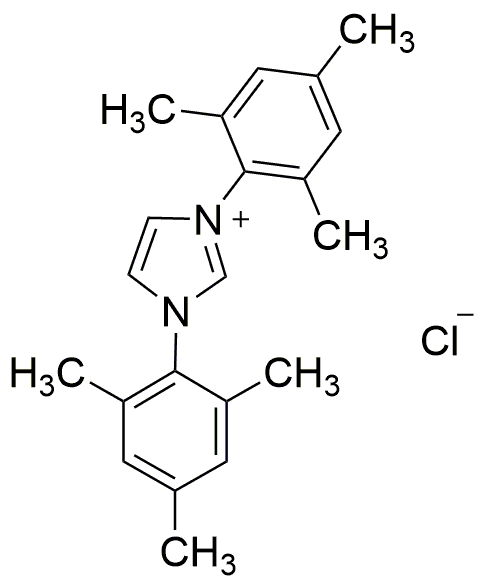1,3-Dimesitylimidazolium chloride is widely utilized in research focused on:
- Catalysis: This compound serves as an effective catalyst in various organic reactions, enhancing reaction rates and selectivity, particularly in cross-coupling reactions.
- Electrochemistry: It is used in electrochemical applications, such as in the development of advanced batteries and fuel cells, due to its excellent ionic conductivity.
- Material Science: This chemical is incorporated into the synthesis of novel materials, including polymers and nanocomposites, which can improve mechanical and thermal properties.
- Pharmaceutical Development: It plays a role in drug synthesis, aiding in the formation of complex organic molecules that are crucial in the pharmaceutical industry.
- Green Chemistry: The compound is recognized for its potential in sustainable practices, as it can facilitate reactions under mild conditions, reducing the need for harsh solvents and reagents.
General Information
Properties
Safety and Regulations
Applications
1,3-Dimesitylimidazolium chloride is widely utilized in research focused on:
- Catalysis: This compound serves as an effective catalyst in various organic reactions, enhancing reaction rates and selectivity, particularly in cross-coupling reactions.
- Electrochemistry: It is used in electrochemical applications, such as in the development of advanced batteries and fuel cells, due to its excellent ionic conductivity.
- Material Science: This chemical is incorporated into the synthesis of novel materials, including polymers and nanocomposites, which can improve mechanical and thermal properties.
- Pharmaceutical Development: It plays a role in drug synthesis, aiding in the formation of complex organic molecules that are crucial in the pharmaceutical industry.
- Green Chemistry: The compound is recognized for its potential in sustainable practices, as it can facilitate reactions under mild conditions, reducing the need for harsh solvents and reagents.
Documents
Safety Data Sheets (SDS)
The SDS provides comprehensive safety information on handling, storage, and disposal of the product.
Product Specification (PS)
The PS provides a comprehensive breakdown of the product’s properties, including chemical composition, physical state, purity, and storage requirements. It also details acceptable quality ranges and the product's intended applications.
Certificates of Analysis (COA)
Search for Certificates of Analysis (COA) by entering the products Lot Number. Lot and Batch Numbers can be found on a product’s label following the words ‘Lot’ or ‘Batch’.
*Catalog Number
*Lot Number
Certificates Of Origin (COO)
This COO confirms the country where the product was manufactured, and also details the materials and components used in it and whether it is derived from natural, synthetic, or other specific sources. This certificate may be required for customs, trade, and regulatory compliance.
*Catalog Number
*Lot Number
Safety Data Sheets (SDS)
The SDS provides comprehensive safety information on handling, storage, and disposal of the product.
DownloadProduct Specification (PS)
The PS provides a comprehensive breakdown of the product’s properties, including chemical composition, physical state, purity, and storage requirements. It also details acceptable quality ranges and the product's intended applications.
DownloadCertificates of Analysis (COA)
Search for Certificates of Analysis (COA) by entering the products Lot Number. Lot and Batch Numbers can be found on a product’s label following the words ‘Lot’ or ‘Batch’.
*Catalog Number
*Lot Number
Certificates Of Origin (COO)
This COO confirms the country where the product was manufactured, and also details the materials and components used in it and whether it is derived from natural, synthetic, or other specific sources. This certificate may be required for customs, trade, and regulatory compliance.


